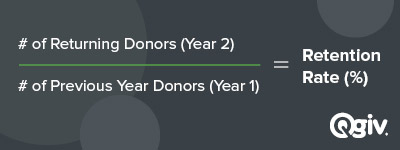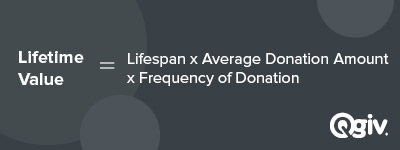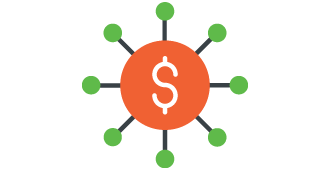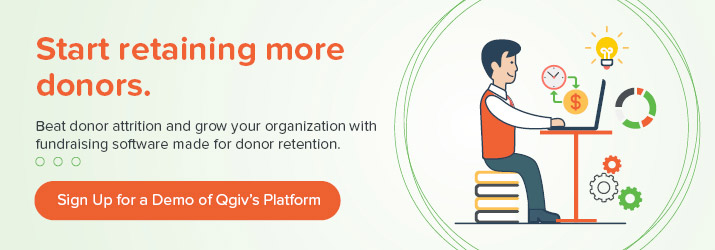Donor retention has long been an issue for many nonprofits. With retention on the decline across the sector, nonprofits need to determine ways they can encourage donors to continue giving.
What is donor retention?
Donor retention is measured by how many donors continue to give to your organization after their first contribution. Nonprofits with a higher donor retention rate maintain their donors year after year, while nonprofits with a lower donor retention rate must acquire new donors to continue running.
Your donor retention rate can have a tremendous impact on your organization. Retaining donors is a more cost-effective way to raise money than recruiting new donors. Without sustained donor retention, nonprofits can’t effectively grow! But leveraging your data and using nonprofit software can help.
That’s why we’ve compiled this essential guide for fundraising to help you understand just how great of an impact donor retention can have on your nonprofit. In this guide, we’ll cover:
Use the navigation to jump to the sections you’re most interested in, or read with us from the top. Let’s get started!
 Donor Retention Rate: Your Questions Answered
Donor Retention Rate: Your Questions Answered

What’s the average donor retention rate?
The average donor retention rate is hovering around 40-45% across the nonprofit sector. This means that if 100 donors give to your organization in a given year, then only about 40 of those donors will give again the following year.

How do you calculate donor retention rates?
Looking at your donor retention rate is an important step for your organization. Getting a donor to give a second time is the first hurdle you’ll encounter, but after that, they’ll be more likely to continue giving.
In order to gather enough actionable data, you should calculate your donor retention rate for each group of donors: new and repeat.
Here’s how you do it:
Identify a group of donors from Year 1. Then, look at the same group of donors in Year 2. How many of those donors donated again in Year 2?
Now calculate your donor retention rate:
# of Returning Donors (Year 2) / # of Previous Year Donors (Year 1) = Retention Rate (%)

For example, if you have 300 donors in Year 1, and 120 of those same donors give to your nonprofit again in Year 2, your donor retention rate will be 120 / 300 = 0.4 (or 40%).
You can apply this formula to any group of donors, including first-time donors and repeat donors.

What’s a healthy donor retention rate?
A healthy donor retention rate will be specific to your organization’s growth goals. You should focus on replacing the donors you lose through donor attrition.
What is donor attrition?
Donor attrition is the percentage of donors that your organization loses from one set period of time to another. It can negatively impact your growth strategy because acquiring new donors costs more than retaining your current ones (think of marketing outreach, direct mail, and staff spending much of their time performing prospect research).
There is a natural turnover rate for donors, however, such as when donors pass away. So, a healthy donor retention rate will depend on what your organization needs in order to keep up and work toward your mission.

How do you calculate the lifetime value of a donor?
If you’re anything like the average nonprofit, you’ll probably lose more first-time donors that you gain. However, the donors you retain after multiple donations down the line are more likely to continue giving, and in larger quantities, because they’ve already proven their affinity to your nonprofit.
This is where the lifetime value (LTV) calculation comes in. LTV is simply a prediction or projection of the value of a donor before they lapse, and can help you make important decisions about your fundraising (such as how much you can afford on appeals, marketing, etc.). The higher the number, the higher the value. The more data you put into your equation, the more accurate your predictions will become.
In order to calculate your LTV, you’ll need: your donor lifespan, average donation amount, and frequency of donation.
Let’s break it down:
Lifespan is the length of time a donor maintains a relationship with your nonprofit. You can determine this by analyzing many years of donation data.
Average donation amount is the average amount of a donation made to your organization by all donors.
Frequency of donation measures the total number of donations made in a specific time period (e.g., years), divided by the total number of donors in that time period. For example, if an organization received 500 donations in a year, and those came from 250 donors, your frequency of donation would be 2. Each donor is making 2 contributions on average.
In order to calculate your LTV, use the following formula:
LTV = Lifespan x Average Donation Amount x Frequency of Donation

Be sure to segment your LTV by giving level or acquisition channel, for example, to make your donor lifetime value more actionable and calculable. By comparing your LTV from one year to the next, you’ll get a big picture of the fundraising health of your organization.
 Donor Retention Statistics: Key Facts for Fundraisers
Donor Retention Statistics: Key Facts for Fundraisers
What is the average recapture rate for lapsed donors?

That’s why it is important for nonprofits to encourage donors to stay involved with their cause and offer easy and convenient ways to give.
What is the percentage of donors who give just once?

In fact, the real benefit of acquiring new donors is retaining them over the long term. Nonprofits today must focus on ways to retain donors in order to stay up and running, otherwise they’ll lose out on much of the investment it took to acquire new donors.
What percentage of gains in giving were offset by losses in giving?

Focusing on findings like these is important so nonprofits can adjust their donor retention strategies. If 96% of gains in giving are being offset by losses, this means that nonprofits need to bring their primary focus on retaining donors, which we will expand on in the next section.
How much has revenue from recurring monthly gifts increased?

In addition, revenue from one-time gifts decreased by 2% in 2018. Without recurring giving, the overall online revenue would have decreased that year.
What is the average donor retention rate for gifts under $100?

This is an interesting metric, as it implies that donors who give in larger amounts are more likely to continue giving to the same nonprofit than donors who give in smaller amounts.

Donor Retention Strategies: 8 Essential Tips
These donor retention statistics are clear; nonprofits struggle to retain donors, which means slow growth and increased spending on new acquisition. It’s important for your nonprofit to examine your data and act on your findings. When you think about your donor retention strategies, think about ways you can engage your donors with resources you already have and tools you might consider investing in.
There are many ways a good nonprofit software and other tools can help boost your donor retention rate:
1. Offering recurring gift options

With nonprofit software that offers recurring gift options on your donation forms, you can provide your donors with a variety of billing frequency options and personalized receipts. Recurring donors tend to give more than one-time doors, so be sure to incorporate this into your strategy.
2. Thanking donors

You should thank your donors as soon as possible following their donation. While the confirmation screen they encounter following the donation may thank them, this is insufficient to rely on alone. Send them a personalized message, be it a letter or email, that thanks them by name, directly mentions their gift, and describes the impact it will make.
3. Sharing impact stories

Incorporate visual storytelling (photos and videos) into your marketing outreach and on your website. Keep your donors informed and ask them to continue taking action. Your appeals can motivate donors to give and contribute to a better outcome.
4. Setting up donor accounts

Donor accounts allow donors to track their recurring donations, make adjustments to their preferences, and keep their information updated with you. This is a win-win for both parties!
5. Offering different ways to give

Providing different ways to give means you’re more likely to meet your donors’ needs. If they want to donate on the go, text fundraising is an easy way to do so. If you want to plan a large event and incorporate a silent auction into the festivities, guests will love the opportunity to browse your items and bid for a greater cause.
6. Offering peer-to-peer fundraising to turn donors into fundraisers

When you engage your supporters in this manner, you’ll make them feel even more engaged with connected to your mission than before. As active fundraisers on your behalf, they can make an impact beyond simply donating money themselves. Build long-term relationships with your supporters and boost donor retention by giving them a key role in your cause.
7. Learning from your donor data

Your nonprofit fundraising software should integrate with a constituent relationship manager (CRM), also referred to as a donor database, which tracks all of your donations and individual donor information so you can leverage it with your fundraising strategy.
Pinpointing trends in giving and following up with lapsed donors, for instance, can be streamlined with the right source of donor data. Make sure you are paying attention to yours.
8. Re-engaging year-end donors

Keep up your engagement by showing appreciation right away and personalizing your outreach. Connect with your donors through social media, interact with them, and encourage them to continue supporting your mission. Your year-end giving campaign doesn’t have to end with donors slipping away after the giving season.
Final thoughts
Without building up your donor retention rate, your nonprofit won’t be able to grow and develop as much as it needs to. Using nonprofit software, however, you can cultivate strong relationships with your donors and boost your donor retention rate significantly as a result.
If you’re looking for more ways to interact with your donors and increase engagement, check out these additional resources below:
- How to Succeed on Social Media During Year-End Fundraising. Year-end fundraising is a hectic, yet helpful, time. Learn how to use social media to boost year-end giving efforts.
- Peer-to-Peer Fundraising | The Ultimate Guide. Peer-to-peer fundraising empowers individuals to raise money on behalf of a nonprofit. Learn how to get started with this and support your fundraising efforts!
- Silent Auctions | The Ultimate Guide for Your Next Event. Silent auctions are excellent fundraisers to add onto a larger event. Explore this guide to learn how to make the most of your next auction.






 Donor Retention Rate: Your Questions Answered
Donor Retention Rate: Your Questions Answered Donor Retention Statistics: Key Facts for Fundraisers
Donor Retention Statistics: Key Facts for Fundraisers


